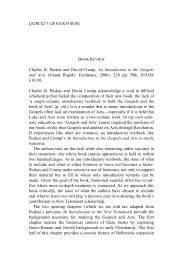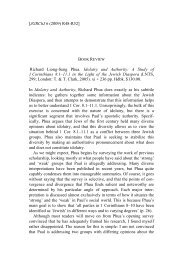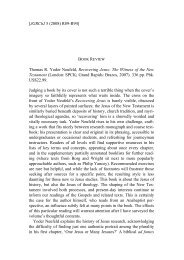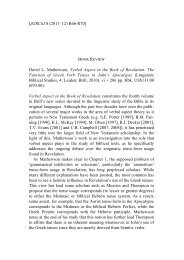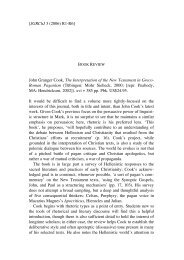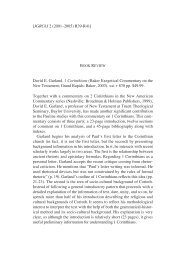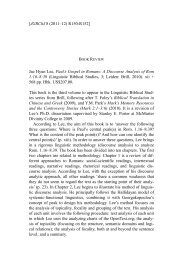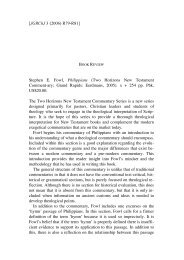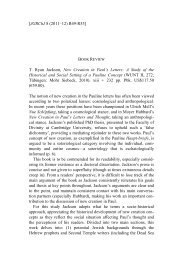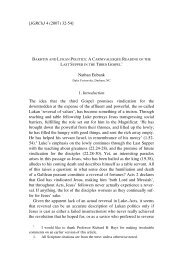The Politics of Ephesians and the Empire - Journal of Greco-Roman ...
The Politics of Ephesians and the Empire - Journal of Greco-Roman ...
The Politics of Ephesians and the Empire - Journal of Greco-Roman ...
Create successful ePaper yourself
Turn your PDF publications into a flip-book with our unique Google optimized e-Paper software.
Gupta & Long <strong>Politics</strong> <strong>of</strong> <strong>Ephesians</strong> <strong>and</strong> <strong>the</strong> <strong>Empire</strong> 113<br />
limited to <strong>the</strong> study <strong>of</strong> Paul. Similar reflections have taken place with<br />
respect to Mat<strong>the</strong>w, 3 John 4 <strong>and</strong> <strong>the</strong> book <strong>of</strong> Revelation, 5 to name only a<br />
few.<br />
Although some commentary writers have explicitly noted <strong>the</strong><br />
political import <strong>of</strong> parts <strong>of</strong> <strong>Ephesians</strong>—e.g. Marcus Barth, <strong>and</strong> more<br />
recently <strong>and</strong> extensively, Charles H. Talbert 6 —fuller treatments <strong>of</strong> this<br />
dimension tend to be restricted to 2.11-22 as seen in Peter Stuhlmacher,<br />
Eberhard Faust, Gosnell Yorke <strong>and</strong> Te-Li Lau. 7 Still, complete treatments<br />
3. See W. Carter, Mat<strong>the</strong>w <strong>and</strong> <strong>Empire</strong>: Initial Explorations (Harrisburg, PA:<br />
Trinity Press International, 2001).<br />
4. See W. Carter, John <strong>and</strong> <strong>Empire</strong> (New York: T. & T. Clark, 2008).<br />
5. See W. Howard-Brook <strong>and</strong> A. Gwy<strong>the</strong>r, Unveiling <strong>Empire</strong>: Rereading<br />
Revelation <strong>The</strong>n <strong>and</strong> Now (Maryknoll, NY: Orbis Books, 1999); S. Friesen, Imperial<br />
Cults <strong>and</strong> <strong>the</strong> Apocalypse <strong>of</strong> John: Reading Revelation in <strong>the</strong> Ruins (Oxford: Oxford<br />
University Press, 2006).<br />
6. See, e.g., <strong>the</strong> sporadic comments on <strong>the</strong> more politically explicit material in<br />
<strong>Ephesians</strong> (Christ seated at <strong>the</strong> right h<strong>and</strong>, Christ bringing peace, etc.) in M. Barth,<br />
<strong>Ephesians</strong> 1–3 (AB; New York: Doubleday, 1974), as he explores various possible<br />
backgrounds; also C.H. Talbert, <strong>Ephesians</strong> <strong>and</strong> Colossians (Paideia: Commentaries on<br />
<strong>the</strong> New Testament; Gr<strong>and</strong> Rapids: Baker, 2007), interprets in ancient political terms<br />
Christ’s bringing peace as Augustan-like (p. 82), <strong>the</strong> body/head language as used by<br />
Seneca <strong>and</strong> Rome/Nero (pp. 86-88), <strong>the</strong> Christian community’s growth into Christ as<br />
<strong>the</strong> ideal ruler (pp. 115-17); however, while discussing <strong>the</strong> <strong>Greco</strong>-<strong>Roman</strong> background<br />
to <strong>the</strong> household codes (pp. 136-39) <strong>and</strong> <strong>the</strong> donning <strong>of</strong> God’s armor (p. 159), Talbert<br />
does not sufficiently correlate <strong>the</strong>se <strong>the</strong>mes to <strong>the</strong> larger political thrust <strong>of</strong> <strong>Ephesians</strong>,<br />
which he certainly underst<strong>and</strong>s: ‘<strong>Ephesians</strong> sets forward <strong>the</strong> Christian community as<br />
equivalent to <strong>the</strong> state, a counterculture over against <strong>the</strong> state…’ (p. 88). Lacking in<br />
Barth <strong>and</strong> Talbert is an underst<strong>and</strong>ing <strong>of</strong> how <strong>Ephesians</strong> addresses <strong>the</strong> socio-religiouspolitical<br />
needs <strong>of</strong> Christ followers in Asia Minor in <strong>the</strong> mid-first century.<br />
7. Peter Stuhlmacher, ‘“He is our Peace” (Eph. 2:14): On <strong>the</strong> Exegesis <strong>and</strong><br />
Significance <strong>of</strong> <strong>Ephesians</strong> 2:14-18’, in his Reconciliation, Law, <strong>and</strong> Righteousness:<br />
Essays in Biblical <strong>The</strong>ology (Philadelphia: Fortress Press, 1986), pp. 182-200; Eberhard<br />
Faust, Pax Christi et Pax Caesaris: Religionsgeschichtliche, traditionsgeschichtliche<br />
und sozialgeschichtliche Studien zum Epheserbrief (NTOA, 24; Freiburg: Freiburg<br />
Universitätsverlag, 1993), who views <strong>Ephesians</strong> as pseudepigraphic <strong>and</strong> dated at <strong>the</strong><br />
end <strong>of</strong> <strong>the</strong> first century; he concludes that <strong>the</strong> political background <strong>and</strong> nature <strong>of</strong><br />
2.11-22 comes from Jewish-gnostic influence (in comparison with Philo), but <strong>the</strong>n<br />
is constructed in view <strong>of</strong> <strong>Roman</strong> imperial ideology (see esp. pp. 221-314; cf. Rainer<br />
Schwindt, Das Weltbild des Epheserbriefes: Eine religionsgeschichtlich-exegetische<br />
Studie [WUNT, 2.148; Tübingen: Mohr Siebeck, 2002], <strong>and</strong> Gerhard Sellin, Der<br />
Brief an die Epheser [MeyerK; Göttingen: V<strong>and</strong>enhoeck & Ruprecht, 2008], who<br />
both likewise underst<strong>and</strong> <strong>the</strong> epistle as deutero-Pauline); Gosnell Yorke, ‘Hearing <strong>the</strong><br />
<strong>Politics</strong> <strong>of</strong> Peace in <strong>Ephesians</strong>: A Proposal from an African Postcolonial Perspective’,



